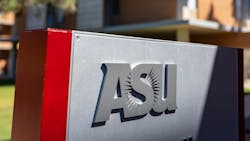DOE Program Takes Action To Enhance And Protect America’s Power Grid
Arizona State University is the recipient of a U.S. Department of Energy grant through the newly announced, $34 million, Grid Overhaul with Proactive, High-speed Undergrounding for Reliability, Resilience, and Security (GOPHURRS) program.
ASU’s project is the High-Speed Installation of Buried Medium Voltage Electrical Distribution Lines Using a Single Pass System.
Samuel Ariaratnam, an ASU construction engineering professor and an expert in trenchless technology, is the principal investigator to develop a water-jet underground construction tool that will deploy medium-voltage electrical cables and conduits simultaneously underground. The new technology will lower the risk to existing utilities by eliminating the need for a hard drill bit, and simultaneously reduce costs and construction times for reaming and duct pulling tasks. The ASU award is $4.3 million over three years.
In 2022, Ariaratnam was appointed by U.S. Secretary of Transportation Pete Buttigieg to the Technical Pipeline Safety Standards Committee, also known as the Gas Pipeline Advisory Committee, or GPAC.
“Unlike current underground utility technologies, like horizontal directional drilling, that require first drilling a bore hole and then pulling a conduit before running the power distribution lines through, the proposed process funded by grant aims to install conduits simultaneously during the excavation process,” explained Ariaratnam.
“This technology has the potential to cut construction costs and time by up to 50%, as well as provide enhanced safety and stability for communities,” he said.
Ariaratnam’s GOPHURRS award is among 12 projects designed to strengthen and modernize America’s aging power grid through the development of cost-effective, high-speed and safe undergrounding technologies.
Administered by the DOE’s Advanced Research Projects Agency-Energy (ARPA-E), the teams include small and large businesses, national labs, and universities. The goal is to create a clean electrical grid by 2035.
ASU’s private industry partners in the project are Vermeer Corp., a global leader in manufacturing underground utility equipment, and Brierley Associates, a consulting design firm that focuses on underground infrastructure.
The team has been working together to write the grant proposal since March of last year.
“Partnering university research exploration with industrial, real-world experience has driven many great advancements,” said Brandon Storm, a design engineer with Vermeer.
Similarly, Brierley welcomes the opportunity to develop new equipment to facilitate upgrades in critical infrastructure.
“Trenchless technologies continue to evolve though research and development. This project will advance the evolution of new excavation and spoil removal techniques to prevent ground fracturing and damage to adjacent structures and facilities,” said Brian Dorwat from Brierley Associates. “This new technology can improve hardening and resilience of our power grid, but can also be applied to other critical utilities.
“The influence of geology is a key principle affecting design and stability of underground construction. Proper geological and geotechnical assessment is critical to anticipating ground behavior during excavation, how the ground will manifest that behavior, and how to efficiently and effectively control ground behaviors during installation. The DOE high speed installation project gives Brierley the opportunity to support advancement of this technology,” concluded Dorwat.
Ariaratnam cites findings from PDi2.org, which has a goal of increasing awareness about underground power infrastructure options. In a recent study, the organization found that “undergrounding” overhead distribution lines has become mainstream, decreasing costs and increasing resilience in the face of climate change.
“Trenchless, underground solutions are the future not only for the power grid, but also for fiber optics, natural gas distribution and other systems that can be adversely affected by disruption,” Ariaratnam said. “And, it will enhance power grid security by eliminating components like towers, making systems undetected and inaccessible above ground.”
According to the DOE, the electric power distribution system in the U.S. has over 5.5 million line-miles with over 180 million power poles, all of which are susceptible to damage by weather and its effects, and account for a majority of power outages in the country each year.
Climate-change fueled extreme weather events are increasing the frequency and intensity of power outages across the U.S., harming communities and disrupting livelihoods.
Undergrounding power lines is a proven way of improving the system reliability for both transmission and distribution grids as weather events are less likely to interfere with systems that are protected below ground. Managed by DOE’s Advanced Research Projects Agency-Energy (ARPA-E), the teams announced today—including small and large businesses, national labs, and universities—will play a critical role in developing technologies to reduce
U.S. Secretary of Energy Jennifer M. Granholm, upon announcing the program, said, “DOE is supporting teams across the country as they develop innovative approaches to burying power infrastructure underground — increasing our resilience and bringing our aging grid into the 21st Century.”
More information and complete project descriptions for the teams announced can be found on the ARPA-E website.
About the Author
T&D World Staff
Content Team
Nikki Chandler
Group Editorial Director, Energy
[email protected]
Jeff Postelwait
Managing Editor
[email protected]
Christina Marsh
Senior Editor
[email protected]
Ryan Baker
Associate Editor
[email protected]
Amy Fischbach
Electric Utility Operations
[email protected]
Rich Maxwell
Community Editor
[email protected]
Gene Wolf
Technical Editor
[email protected]
